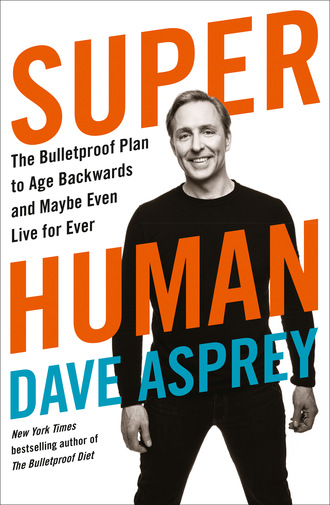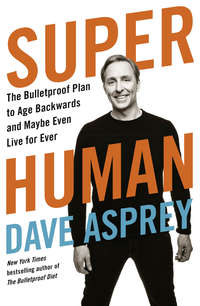
Полная версия
Super Human
Yet, since I made my first cup in 2004, I’ve continued to discover more reasons why it works. To my surprise, one of them has to do with melanin, the pigment in your skin, which also exists in other parts of the body. When exposed to sunlight or mechanical vibration, new research indicates that melanin likely has the power to break apart water molecules, freeing up oxygen and electrons that your mitochondria can use to make energy.24 Our bodies actually create melanin by linking together polyphenols, chemicals that occur naturally in plants. Polyphenols are packed with antioxidants and thus offer us a powerful defense against aging. The best ways to stimulate melanin production are to eat plenty of leafy green plants and herbs, drink tea and coffee, get adequate sun exposure, and exercise regularly.
This new information about melanin made me think back to my time in Tibet. I noticed that locals who carried all their belongings on the backs of yaks made sure to always have blenders hooked to portable batteries just to make yak butter tea. They were clearly onto something. Tea and coffee contain large amounts of polyphenols. Coffee also contains melanin and similar compounds called melanoids. Is it possible that Bulletproof Coffee and yak butter tea are so energizing because the mechanical vibrations from the blender break up the melanin and melanoids,25 providing free oxygen and electrons for your mitochondria? Is this why the yak butter tea made me feel so much better in high altitudes where there was less oxygen? I think so.
COFFEE + TIME = KETONES
Recently I interviewed Satchin Panda, a leading researcher on circadian rhythms, the natural twenty-four-hour cycles of all living beings, and learned something new about Bulletproof Coffee. According to Satchin, it’s part of our natural rhythm to start producing ketones at the end of our fasting cycle. For most of us, that would be in the morning before we break our fast with the aptly named meal, breakfast.
Those ketones have a huge impact on our cardiovascular and brain health. Satchin observed that when mice produce ketones toward the end of their fasting cycle, those ketones go directly to brain cells called clock neurons, which monitor the environment in the brain and help to regulate circadian rhythm. When ketones reach those clock neurons, they receive a signal to become awake and alert and begin what is called exploratory activity. Of course exploratory activity is more pleasant than desperately wanting to hit the snooze button in the morning.
This makes perfect sense from an evolutionary perspective. Just a couple hundred years ago, our ancestors fasted all night and then had to hunt for food in the morning. Their brains and muscles had to work really well in that hungry state in order to successfully find food, and ketones were the answer. This is why we are programmed to build up ketones during the last couple of hours of our fasting period. Those ketones give our brains, muscles, and hearts more energy so we can hunt—exactly what Satchin has seen in his lab rats. An hour or two before they were fed in the morning, they got up and started looking around, exploring, and getting ready to hunt.
The problem is that most people don’t fast long enough to take full advantage of this biological phenomenon. According to Satchin, there are tremendous health benefits to extending our daily (or nightly) fast. He says that when people limit their eating window to ten hours and make no other dietary changes, they see reductions in inflammation levels, triglyceride levels, and cancer risk, along with improvements in sleep within weeks. Is this because of the natural boost in ketones or because intermittent fasting boosts autophagy—or both?
But remember, you do better when you practice ketosis intermittently. Staying in ketosis for long periods of time compromises your metabolic flexibility—your body’s ability to burn either glucose or ketones for fuel. Maintaining metabolic flexibility is incredibly important for your longevity. There are two states your body must be able to handle effortlessly. The first is periods with ketones and no carbs, and the second is periods with carbs and no ketones. To gain metabolic flexibility, the best thing you can do is cycle in and out of ketosis every week. To do this, you limit carbohydrate intake most days, and on one to two days per week you eat low-sugar carbs. While this works for die-hard biohackers, most people enjoy eating more carbs. With the power of technology, it is possible to have both ketones and carbohydrates present in your body at the same time, which can also generate metabolic flexibility. To do this, eat moderate low-sugar carbohydrates like white rice or sweet potatoes, and at the same time consume lots of energy fats. That way, you’ll have some ketones present for your neurons and some glucose present for your brain’s maintenance cells. Most people find this more sustainable than a pure cyclical ketogenic diet, but both work.
There is no doubt that strategies like ketosis, intermittent fasting, and the maintenance of a healthy circadian rhythm play a critical role in our longevity. This leads to the next essential step on our quest to become Super Human—and that is getting enough highly efficient, good quality sleep.
Bottom Line
Want to not die? Do these things right now:
• Avoid all conventionally grown grains, produce, and animal products. Even better, skip grains altogether and opt for tons of organic vegetables, limited organic fruit, and meat from pastured animals.
• Don’t eat fried stuff. Ever.
• Eat enough protein (from pastured animals, eggs, wild fish, or nonallergenic plants) for tissue repair and an additional 20 plus grams of grass-fed collagen, and don’t fry, char, blacken, or barbecue meat (sorry). For lean people, that’s 0.5 grams per pound of body weight. For obese people, that’s about 0.35 grams per pound of body weight. For pregnant women, elderly folks, or athletes, it’s 0.6 grams per pound.
• No matter how much fat or how little fat you eat, eat the right ratios. Lean people eat about 50 percent saturated, 25 percent monounsaturated, and 15 to 20 percent undamaged omega-6 and 5 to 10 percent omega-3, including EPA and DHA. If you are fat like I used to be and want to live like a Super Human, eat 50 to 70 percent saturated, 25 to 30 percent monounsaturated, and only 10 percent undamaged omega-3 and omega-6, with added EPA and DHA so that you eat more omega-3 than omega-6.
• On some days, limit your eating window to eight to ten hours a day based on what works best for your schedule. Good options are 12:00 P.M.–8:00 P.M., 9:00 A.M.–5:00 P.M., or 10:00 A.M.–7:00 P.M. Have breakfast sometimes, especially if you’re tired or stressed. Don’t eat after dark.
• Teach your metabolism to be flexible by having ketones present in your system every week. Practice a cyclical ketogenic diet by fasting, avoiding carbohydrates for a few days, or adding “energy fats” to your food (or coffee) that convert directly to ketones.
Конец ознакомительного фрагмента.
Текст предоставлен ООО «ЛитРес».
Прочитайте эту книгу целиком, купив полную легальную версию на ЛитРес.
Безопасно оплатить книгу можно банковской картой Visa, MasterCard, Maestro, со счета мобильного телефона, с платежного терминала, в салоне МТС или Связной, через PayPal, WebMoney, Яндекс.Деньги, QIWI Кошелек, бонусными картами или другим удобным Вам способом.




